#lammas ritual
Explore tagged Tumblr posts
Text




I wanted to burn John Barleycorn (last year's corn dolly) after dismanteling him along with the song but couldn't do it litterally. Pretty happy with the way I found to do it symbolically.
#lammas#kronia#john barleycorn#altar#leyswitchblr#witchblr#sabbath#witchcraft#pagan witch#paganism#lammas altar#lughnasadh#ritual#John Barleycorn must die#in the end he proved the strongest man of all#you cant do anything without a little barleycorn
16 notes
·
View notes
Text






Lughnasadh has always been among my favorite holidays. It has always signaled a turning point. In the past that was the end of an open schedule and a turn back towards structure and focus for school. These days it is the opposite: it heralds that autumn is coming and that things will begin to slow a little. The hustle of summer is still going strong but the first harvest means that cooler days and a less busy time are not far away.
It had been since before the pandemic that I had celebrated. I had intended to make a wicker man and have a bonfire last night with friends, but time just didn’t allow for it. I did however get to do the essential thing: get my hands dirty doing something in honor of the season and spend time with good friends. Last night we made a feast of Irish coddle, green beans and fried mushrooms, soda bread and pumpkin bread. We made little wreathes tied with blessings and wishes for the dark half of the year ahead, and that is enough for me. Autumn is not far away, and I cannot wait for it.
#lughnasadh#druidry#witchcraft#witchblr#pagan#paganism#lammas#calan awst#Lughnasadh rituals#personal
70 notes
·
View notes
Text
Lammas Bread Recipe
2 c whole wheat flour
2 c bread flour plus more as needed
1/4 c toasted sesame seeds
2 Tbs pactive dry yeast
2 1/2 tsp salt
2 c scalded milk
3 Tbsp smooth peanut butter
3 Tbsp honey
Mix all the dry ingredients in a large bowl. Add the peanut butter and the honey to the hot milk and stir to combine.
Cool milk mix until it reaches 115ºF. Stir milk mix into flour mix. Knead for 15 minutes, adding more flour if necessary to make a smooth, elastic dough Oil the dough's surface, then cover with plastic or a damp towel. Let it rise in a warm spot until double. Punch down, then shape into 2 rectangle loaves or one large wreath.
Let rise again until doubled. Bake at 375ºF until golden; it should make a hollow sound when tapped.
#bread#bread recipe#rituals#kitchen witch#hellenic pagan#hellenic polytheism#hellenic worship#lammas#autumm#lughnasadh
33 notes
·
View notes
Text

Set the table
Fill it right
Dress it up
Heed the light.
The first harvest
Still hold true
Filling us with
Ancient roots.
Eat the power
Drink the love
Remember the
Gods above.
All the living
Take the gift
Of nourishment
And harvest.
2 notes
·
View notes
Text
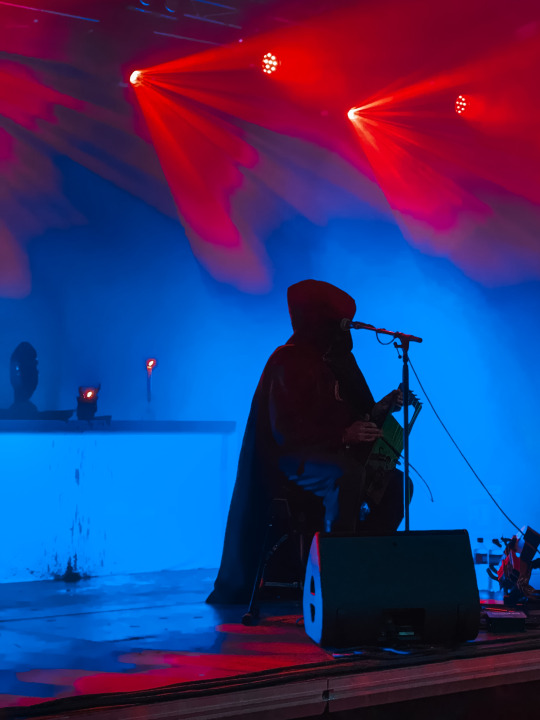
© Priestess of the North-West.
@forndom @castlefest yesterday. Stunning and glorious. Thank you for your heartfelt gift at the end.
5 notes
·
View notes
Text
remember yall, the full moon falls one lammas! i was thinking of making sure banana bread or maybe banana bread muffins and cover them in white chocolate or something to be the moon
0 notes
Text
August 2024 Witch Guide
New Moon: August 4th
First Quarter: August 12th
Full moon: August 19th
Last Quarter: August 26th
Sabbats: Lughnasadh/Lammas- August 1st
August Sturgeon Moon
Also known as: Barely Moon, Black Cherries Moon, Corn moon, Dispute Moon, Harvest moon, Herb Moon, grain moon, Mountain Shadows Moon, Red moon, Ricing Moon, Weodmonath & Wyrt moon
Element: Fire
Zodiac: Leo & Virgo
Animal spirts: Dryads
Deities: Diana, Ganesha, Hathor, Hecate, Mars, Nemesis, Thot & Vulcan
Animals: Dragon, lion, phoenix & sphinx
Birds: Crane, eagle & falcon
Trees: Alder, cedar & hazel
Herbs: Basil, bay, fennel, orange, rosemary, rue & St.John's wort
Flowers: Angelica, chamomile, marigold & sunflower
Scents: Frankincense & heliotrope
Stones: Carnelian, cats/tiger's eye, emerald, fire agate, garnet, jade, moonstone, peridot, red jasper, red agate, sardonyx, topaz & tourmaline
Colors: Dark green, gold, orange, red & yellow
Energy: Abundance, appreciation, authority, courage, entertainment, finding your voice, friendship, gathering, harvesting energy, health, love, pleasures, power, prophecy, prosperity, vitality & wisdom
The name Sturgeon Moon comes from the giant lake sturgeon of the Great Lakes & Lake Champlain; this native freshwater fish was readily caught during this part of summer & an important food staple for Native Americans who lived in the region. At one time the lake sturgeon was quite abundant in late summer, though they are rarer today.
• August's full moon is the first Supermoon of the year, which means that it will appear bigger & brighter than the full Moons we have seen so far!
Lughnasadh
Known as: Lammas, August Eve & Feast of Bread
Season: Summer
Element: Fire
Symbols: corn, grain dollies & shafts of grain
Colors: Gold, golden yellow, green, light brown, orange, purple, red & yellow
Oils/Incense: Aloe, apple, corn, eucalyptus, safflower, rose & sandalwood
Animals: Cattle (bull & calf)
Birds: Chicken/Rooster
Stones: Aventurine, carnelian, citrine, peridot, sardonyx & yellow diamond
Food: Apples, barely cakes, berries, berry pies, breads, colcannon, cider, corn, grains, honey, lamb, nuts, potatoes, rice, sun-shaped cookies & wild berries
Herbs/Plants: Alfalfa, aloe, blackberry, bramble, corn, cornsilk, corn stalk, crab apple, fenugreek, frankincense, ginseng, goldenseal, gorse, grape, medowsweet, oak leaves, pear, rye, sloe & wheat
Flowers: Clyclamen, heather hollyhock & sunflower
Trees: Acacia, apple, myrtle,oak & rowan
Goddesses: Aine, Alphito, Bracacia, Carmen, Ceres, Damina, Danu, Demeter, Ereshkigal, Freya, Frigga, Gaia, Inanna Ishtar, Kait, Persephone, Sul, Taillte, Tea & Zaramama
Gods: Athar, Bes, Bran, Dagon, Dumuzi, Ebisu, Ghanan, Howtu, Liber, Lono, Lugh, Neper, Odin & Xochipilli
Issues, Intentions & Powers: Accomplishment, agriculture, challenges, darkness, death, endings, release & transformation
Spellwork: Abundance, bounty, fire magick, rituals of thanks & sun magick
Activities:
• Bake fresh bread
• Weave wheat
• Take walks in nature or along bodies of water
• Craft a corn doll
• Learn a new skill
• Watch the sunrise/sunset
• Leave grains and seeds in a place where birds, squirrels and other small animals can appreciate them
• Eat outside with family/friends/coven members
• Donate to your local foodbank
• Prepare a feast with your garden harvest
• Give thanks & offerings to the Earth
• Trade crafts of make deals
• Gather and/or dry herbs to use for the upcoming year
• Celebrate/honor the god Lugh by hosting a competition of games
• Participate in matchmaking or handfasting ceremonies
• Decorate your altar with symbols of the season
• Clean up a space in nature
• Plant saved seeds or save seeds to use in the future
Lughnasadh or Lammas is a Gaelic festival marking the beginning of the harvest season. Historically it was widely observed throughout Ireland, Scotland & the Isle of Man. Traditionally it is held on 1 August, or about halfway between the summer solstice & autumn equinox. In recent centuries some of the celebrations have shifted to the Sunday nearest this date.
Lughnasadh is mentioned in early Irish literature & has pagan origins. The festival is named after Lugh the god of craftsmanship. It was also founded by the god Lugh as a funeral feast & athletic competition/funeral games in memory of his foster-mother Tailtiu. She was said to have died of exhaustion after clearing the plains of Ireland for agriculture.
• Tailtiu may have been an earth goddess who represented the dying vegetation that fed mankind.
• Another tale says that Lugh founded the festival in memory of his two wives, the sisters Nás & Bói.
In the Middle Ages it involved great gatherings that included ceremonies, athletic contests (most notably the Tailteann Games which were extremely dangerous), horse racing, feasting, matchmaking & trading.
• With the coming of Christianity to the Celtic lands, the old festival of Lughnasadh took on Christian symbolism. Loaves of bread were baked from the first of the harvested grain & placed on the church altar on the first Sunday of August. The Christianized name for the feast of Lughnasadh is Lammas which means “loaf mass”.
Some believe this is the time where the God has weakened & is losing his strength as seen in the waning of the day's light. The Goddess is pregnant with the young God who will be born on Yule.
Sources:
Farmersalmanac .com
Llewellyn's Complete Book of Correspondences by Sandra Kines
Wikipedia
A Witch's Book of Correspondences by Viktorija Briggs
Encyclopedia britannica
Llewellyn 2024 magical almanac Practical magic for everyday living
#witch guide#August 2024#Sturgeon moon#wheel of the year#sabbats#lughnasadh#lammas#full moon#witchblr#paganblr#wiccablr#witches of tumblr#tumblr witches#witch community#witchcore#witchcraft#traditional witchcraft#witch tips#beginner witch#baby witch#August Witch Guide#GreenWitchcrafts#moon magic#grimoire#book of shadows#spellbook#spellwork#witches#witch#supermoon
298 notes
·
View notes
Text
WAYS TO CELEBRATE THE SABBATS
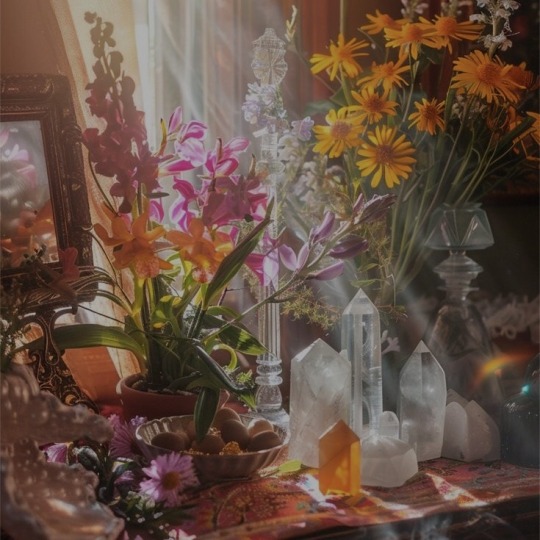
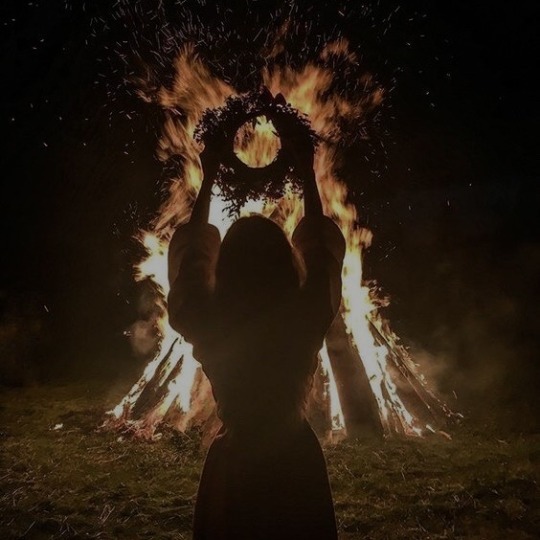
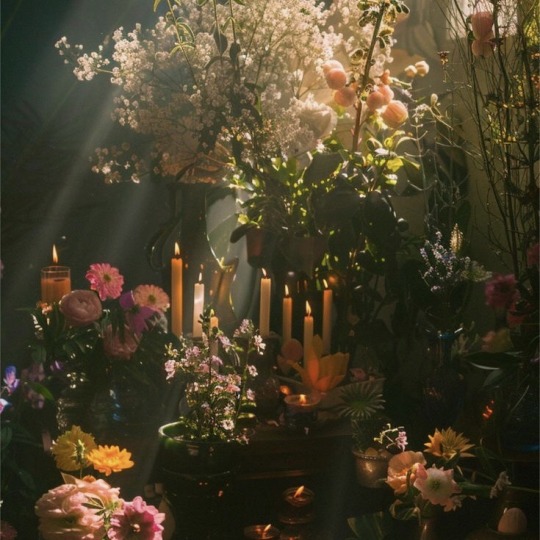
IMBOLC (CANDLEMAS)
Clean your home and space to welcome the coming of spring.
Bake a traditional Imbolc loaf of bread or other seasonal foods.
Use the colours white and yellow in your decorations and outfits.
Light a bonfire or light candles to represent the returning light.
Plant seeds or bulbs to symbolize the rebirth of nature.
Perform a ritual to honour the coming of spring and ask for protection and blessings.
Make a Brigid's cross or other handcrafted decorations with herbs and other natural materials.
Perform a blessing of your home and surroundings with holy water or smoke cleansing.
Set up an altar or sacred space to honour the Celtic goddess Brigid, associated with Imbolc.
Make Brigid's bed, a traditional ritual of placing straw under your bed to bring fertility and growth into your life.
Connect with nature and spend time outside to honour the changing season.
OSTARA (SPRING EQUINOX)
Participate in fertility rites and rituals to celebrate the coming of spring and the planting season.
Decorate your altar or sacred space with symbols of Ostara, such as eggs, bunnies, daffodils, and pastel colours.
Perform a spring cleaning of your home and life, releasing old habits and welcoming new beginnings.
Light a fire or light candles to honour the return of lighter, longer days.
Bake a traditional honey cake or other seasonal sweets to celebrate the sweetness of spring.
Plant seeds or herbs for new growth and prosperity.
Go for a nature walk or hike to connect with the natural world.
Participate in an egg hunt or egg rolling, traditional Ostara games
Perform a protection spell or ritual to honour the increasing light and longer days.
Practice self-care rituals to nourish and rejuvenate your mind and body.
BELTANE (MAY EVE)
Celebrate the fertility of the earth with bonfires and rituals honouring the fire god, Belenos.
Make a maypole and decorate it with colourful ribbons.
Participate in a maypole dance, a traditional celebration of fertility and joy.
Make a wish list and tie it to a tree on Beltane eve.
Collect flowers, especially May blossom or hawthorne flowers, and make a garland or crown to wear.
Create a flower crown or wear one made of wildflowers to honour the faery folk and fertility spirits.
Perform a ritual to bless your home and land for prosperity and protection.
Jump over the Beltane bonfires, symbolizing jumping over obstacles and embracing new beginnings.
Have a picnic or gathering with friends and family to celebrate the abundance and growth of the season.
Create a sacred space or altar for Beltane, decorat with flowers, herbs, and other nature-related objects.
Perform a cleansing ritual to rid yourself of negative energy and welcome the energy of new beginnings.
Make a bouquet of wildflowers or herbs, and hang it on your front door to welcome the spirits of Beltane.
Go for a walk in the woods or a natural setting and connect with the beauty and energy of the season.
LITHA (SUMMER SOLSTICE/MIDSUMMER)
Participate in a bonfires or lighting a sacred fire, celebrating the arrival of the longest day of the year.
Collect herbs and flowers, especially ones associated with the sun, such as calendula, yarrow, and St. John's wort, and make a solstice garland.
Perform a ritual to honour the sun and ask for protection and blessings.
Dance around the bonfire or engage in other traditions associated with the Summer Solstice, such as singing and drumming.
Have a solstice feast, filled with summer bounty, seasonal foods, and family.
Celebrate in the natural world, go for a walk, or have a picnic during the longest day.
Honour the Celtic goddess Litha, associated with the Summer Solstice.
Start summer resolutions.
Get your hands dirty and embrace the earth. Consider planting a vegetable garden for fall harvest or add to your flower garden to mark the occasion.
LAMMAS (LUGHNASADH)
Baking bread.
Crafting corn dolls.
Pick wild flowers.
Honour the earth and the cycles of nature.
Perform Sun magick.
Give thanks to the spirits and/or deities for the beginning of the harvest season.
Collect and honour the first fruits of the harvest, such as grains, corn, and apples.
Perform a ritual to honour Lugh and thank the gods and goddesses for the harvest.
Hold a harvest festival or feast, sharing the bounty of the land with family and friends.
Make a Lughnasadh altar or shrine with symbols of the harvest, such as corn, grains, and apples.
Participate in a traditional Lughnasadh celebration, such as a harvest dance or ritual.
Collect herbs and plants for healing and protection, as Lughnasadh is traditionally a time for preparing for the winter months.
MABON (AUTUMN EQUINOX/FALL HARVEST)
Celebrate the balance between light and dark, and the onset of the harvest season.
Honour the Celtic god Mabon, associated with the Autumn Equinox.
Participate in a harvest celebration, collecting and honouring the fruits of the land.
Make a corn dolly or a straw figure as a reminder of the abundance of the harvest.
Perform a ritual to honour the balance of the seasons and thank the gods and goddesses for their blessings.
Spend time writing in your journal. You could reminisce about your summer experiences, reflect on the shifts you feel with the changing season, contemplate what you're ready to release, or express gratitude for the blessings in your life.
Participate in a nature walk or ceremony, taking time to connect with the natural world and the turning of the seasons.
Enjoy your favourite fall beverages.
Make a gratitude list or write a gratitude letter, expressing your appreciation for the abundance and beauty of the harvest season.
Connect with nature.
Bring the beauty of fall indoors by decorating your home with seasonal touches.
Performing a gratitude or release ritual.
SAMHAIN (ALL HALLOWS/FINAL HARVEST)
Carving pumpkins with friends.
Relax and watch some horror movies.
Treat yourself to sweets.
Participate in a haunted house, hayride, or corn maze event.
Declutter/organize your home.
Focus on letting go to make space for the new year.
Collecting leaves.
Bake treats that contain pumpkin.
Creating a spooky, atmospheric decor for your home or workspace, such as cobwebs, faux spiders, and other creepy décor items.
Gathering friends and loved ones for a Samhain feast, feasting on symbolic foods like apples, pumpkin, or corn.
Visit a local pumpkin patch.
Making personalized altar items and decorative pieces for your sacred space, such as witch jars, mandalas, sigils, symbols of the harvest, items associated with death, etc.
Participating in a divination practice like tarot reading, scrying, or rune casting to gain insight and connect with the energy of the night.
Go to a harvest festival or carnival.
Hold a Samhain seance or mediumship session to contact the spirits of loved ones who have passed on.
Participate in a potluck dinner with witches and pagans, dressing in traditional Samhain garb.
RESPECTFULLY visit a graveyard.
YULE (WINTER SOLSTICE/MIDWINTER)
Burn a Yule log.
Make an evergreen Yule wreath.
Decorate a Yule tree.
Make a Yule wish list or a Yule resolution, as Yule is a time of reflection and intention setting.
Practice Yule carol singing, participating in a community sing-along or carolling event.
Celebrate in candle light.
Give back to nature.
Exchange nature-based gifts.
Host a feast for those you love with foods associated with Yule, such as: roast goose, Yule ham, nuts, berries, spices, squash, and potatoes.
Eat or make/bake Yule ham, gingerbread, mulled wine, roast goose, spiced cakes, shortbread, snowball, caraway, ginger snaps, honey cakes or pastries, and biscuits.
Eat or give sweets flavoured with nutmeg, cinnamon, ginger, or peppermint.
Participate in the longest night of the year and prepare for the return of the light.
Honour deities associated with Yule, such as Odin, Baldur, Hel, Loki, Sol, Freyr, Njörðr with lights, candles, and bonfires.
Participate in a Yule spell or ritual, asking for blessings and protection for the coming year.
Decorate your home with evergreen boughs and wreaths, representing the evergreen nature of the sun and eternal life.
Host a Yule log ceremony.
Participate in an outdoor activity, like sledding or ice skating, to honour the winter season.
#fyp#fypシ#fypシ゚viral#fypage#fyppage#tumblr fyp#witchcraft#witches#witch#witchcore#witchblr#witch community#sabbats#imbolc#ostara#spring equinox#beltane#midsummer#litha#lughnasadh#lammas#autumn equinox#mabon#fall harvest#samhain#all hallows eve#yule#winter solstice#information#wheel of the year
115 notes
·
View notes
Text
Herbs & Correspondences G-L

Galangal Root - Also called Lo John the Conqueror or Lo John. Carry into legal proceedings to help win. Money, gambling and hex breaking. Also aids luck and psychic development. Element Fire.
Garlic - Magical uses include speed, health and endurance, also protection, exorcism and purification. Use also to promote your inner strength. Element Fire.
Gentian - Increases spell power. Good luck and works well in love & romance spells. Element Fire.
Ginger - Increases magic power. Success, love, money and power. Element Fire.
Ginseng - Promotes love, beauty, healing and lust. Element Fire.
Hawthorn Wood- Associated with Beltane. Magical uses include chastity, fertility, fairy magic, fishing magic, and rebirth. Success in career, work, and employment. Use it to work with the fae. Used in weddings and handfasting's to increase fertility. Element Water. Hawthorne Berries aid chastity. Hope, protection and happiness. Element Fire.
Hearts Ease - Also called Violet. It helps to mend a broken heart. Aids rebirth, peace, wishes and luck. Calms the nerves and promotes peace and tranquility. Element Water.
Hemlock - Use to paralyze a situation and a funeral herb. Highly Toxic. Element Water.
Henbane - Dried leaves are used in the consecration of ceremonial vessels. Used in love sachets and charms to gain the love of the person desired. Highly Toxic. Element Water.
Hibiscus - Attracting love and lust. Use in divination. Associated with lunar magic. Element Water.
High John - (The Conqueror) An "all purpose" herb. Use it for strength, confidence, conquering any situation. Good luck, prosperity and protection. Element Fire.
Holly Hock - Protecting, all Fairy magic, abundance, personal growth and aids passing. Related to Lammas. Element Earth.
Horehound - Protective against evil doings. Helps with mental clarity during ritual; stimulates creativity/inspiration; balances personal energies and healing. Element Earth.
Horsetail - Use for strength and resolve. Protection, cleansing and clearing unwanted emotions. Element Earth.
Hyssop - Used for purification. Banishing, protection and healing. Element Fire.
Irish Moss - Used for luck. Ideal for gamblers! Attracts money and customers for self-employed. Offers protection. Element Water
Ivy - Protection, healing and fertility. Use for love and hang at handfasting's. Element Fire.
Jasmine - The herb of attraction. Helps prophetic dreaming, money and love. Element Water.
Juniper - See Cedar berries.
Lady's Mantle - Aphrodisiac and transmutation. Use in love spells and those of fertility. Increases magic power in spells and connects with fairy lore. Element Water.
Laurel- See Bay leaf.
Lavender - Magical uses include healing, sleep and peace. It also promotes chastity and love. Increases longevity of life, tranquility and happiness. Element Air.
Lemon Balm - Also called Melissa. Love, success and healing. Aids psychic/spiritual development. Supports mental health disorders and compassion. Element Water.
Lemon Grass - Psychic cleansing and opening. Use in lust potions and when using Dragon Magic. Element Air.
Licorice Root - Love, lust, and fidelity. Also attracts passion. Element Water.
Lilac - Wisdom, memory, good luck and spiritual aid. Element Water.
Linden Flower - Wisdom, justice, love and protection. Element Air.
Lime Tree Leaf - Healing, calm and love. Aids strength and tranquility. Element Air.
Little John - See Galangal root.
Lungwort - Use in air magic or as an offering to the Gods of air. Offers safe travel when flying. Element Air.
#witch#witchcraft#witchblr#pagan#wicca#witches#pagan witch#paganism#pagan wicca#polytheism#herbsforspells#herbalism#herbs#herb correspondences
349 notes
·
View notes
Text
✿ A list of most (if not all) wicca holidays
✮ Lammas (Lughnasadh) – Pagan/Wiccan Aug 1st
Lammas, also known as Loafmas or Lughnasadh, commemorates the harvest of the first grains, primarily for breadmaking. Lughnasadh itself is named after Lugh, a Celtic deity associated with grain. Lammas celebrations include feasting, crafting corn dollies, and participating in games and contests as a way to honor Lugh and the bounty of the season.
✮ Mabon (Fall Equinox) – Pagan/Wiccan Sept 21st
Mabon, celebrated at the fall equinox, marks the transition to the approaching darkness of the coming winter months. Mabon celebrations involve giving thanks for the harvest, making offerings of fruits and vegetables, and performing ceremonies to honor the equinox’s change from the light half of the year to the dark. Decorations made of corn, squash, vines and pumpkins are common.
✮ Samhain (All Hallows Eve) – Pagan/Wiccan Oct 31st
Samhain today marks the end of the harvest, the start of the Pagan/Wiccan New Year, and the honoring of our ancestors and the dead. Samhain celebrations include lighting candles, setting up altars, and modern activities like costume parties, trick-or-treating, and jack-o’-lanterns.
✮ Yule (Winter Solstice) – Pagan/Wiccan Dec 21st
Yule, celebrated at the winter solstice, marks the day on which the “sun is reborn.” Yule celebrations include the burning of the Yule log, kissing under the mistletoe, decorating homes with holly and evergreen branches, and performing rituals to welcome the return of the sun’s warmth and light to the world.
✮Imbolc (Candlemas) – Pagan/Wiccan Feb 2nd
Imbolc heralds the first signs of spring and is dedicated to Brigid, a Celtic goddess of poetry and fire who was later canonized by the Catholic Church. Imbolc celebrations include candlelit processions, the lighting of a hearth fires, and sending blessings to the fields and farm animals.
✮Ostara (Spring Equinox) – Pagan/Wiccan May 21st
Ostara, celebrated at the spring equinox, marks the beginning of the light half of the year and the arrival of spring. Ostara is celebrated by the coloring and decorating of eggs, planting of seeds, and performing rituals that honor the balance of light and dark.
✮Beltane (May Day) – Pagan/Wiccan May 1st
Beltane is a joyful fertility festival that welcomes the height of spring and celebrates the divine feminine and masculine coming together in fruitful union. Beltane celebrations include dancing around the Maypole, wearing wreaths or crowns of flowers, the crowning of a May Queen, and the lighting of bonfires.
Litha/Midsummer (Summer Solstice) – Pagan/Wiccan June 21st
Litha, celebrated at the summer solstice, marks when the sun is at its maximum power and the longest day of the year. Litha celebrations include lighting bonfires, outdoor feasts, and rituals that honor the warmth and light of the sun and the season’s abundance.

#coven#witch coven#witchcraft#witches#witchblr#witchcore#green witch#witch community#witch aesthetic#witchy vibes#paganblr#pagan community#pagan witch#paganism#pagan#hellenic pagan#wiccan#pagan wicca#wiccablr#wicca#wiccalife#black girl magic#magical girl#healing#ritual#spells#spellcasting#spellcraft#spellwork#magic
86 notes
·
View notes
Text

Thu, 1 Aug 2024
Also known as Lammas, Lughnasadh is the first of three autumn celebrations in the Wheel of the Year. Lughnasadh is celebrated on August 1, which is in the sign of Leo, when the sun reaches 15 degrees of Leo.
2024 Wheel of the Year (Sabbats)
Pagan Wheel
Feb 2 – IMBOLC (also called Candlemas, Imbolg, and Saint Brigid’s Day) It is midway between the Winter Solstice and Spring Equinox. This sabbat reminds us that the light is growing stronger and that the harshness of winter will start to fade. To celebrate the growing light, many Pagans will light candles on this holiday.
Mar 19 – OSTARA /Spring Equinox: light and darkness are in perfect balance on this day. Moving forward, daylight will continue to grow as we head into Spring. It is a time to celebrate balance and the arrival of Spring. It represents new beginnings and the freshness of a new day. What’s past is in the past and past and it’s time to move forward.
May 1 – BELTANE (also known as May Day) (pronounced BELL-tain) This is an exciting and energetic holiday that celebrates sexuality, fertility, and all of the life that comes with Spring. It is a time of great joy and celebration! Feel the creative energy of the Universe. It is a time of renewal and rebirth … a time to grow as a person and reinvent yourself if you so desire.
June 20 – LITHA / Summer Solstice The Sun is at its maximum strength … it is the longest day of the year. This is a season of growth, fruitfulness, abundance, and strength. It’s a great night to perform spells for money, abundance, and financial security … and the strength to do what you need to do to be successful.
June 23 – Midsummer’s Eve: the night before Mid-Summer (June 24). It is considered a night of potent magick. Many Witches will be performing rituals and casting spells on this night. It is also a night when fairies roam the land. If you work with the fairy realm, this is an important night for you!
Aug 1 – LAMMAS (also known as Lughnassadh) the first harvest festival. It celebrates the first grains harvested for baking bread. Celebrate by baking or buying a loaf of bread and sharing it as a celebration.
Sept 22 – MABON / Fall Equinox: the light and darkness are in balance on this day. But it marks the change from the light half of the year to the dark half of the year. Moving forward the darkness will grow longer and the daylight will grow shorter. It is a celebration of the second harvest festival and is celebrated by feasting and visiting with family and friends.
Oct 31 – SAMHAIN (pronounced SAH-win) (as known as Halloween) This is the Witches’ New Year! The veil between worlds is thinnest and the dead are thought to return and visit. It is a night to communicate with the spirits, spirit guides, and ancestors. It is also a night to work with Tarot cards and Crystal Balls!
Samhain is also a time when we come to terms with death and are openly encouraged to let go of our fears of it. It is a time when we acknowledge the hard moments of life that we usually don’t think or talk about. If there are things we need to let go of, Samhain is a good time to release them!
Dec 21 – YULE / Winter Solstice: The real reason that this time of year was celebrated .. before christianity existed. We are halfway through the dark part of the year. The darkness is at its peak…moving forward the light begins to grow stronger and days become longer. You can see why the newly formed cult of christianity, which is what it was at the time, choose this time of year for the birth of christ…the light grows strong and brighter…the Sun is reborn. Yule traditions include burning a Yule log, kissing under mistletoe, and placing an evergreen tree in your home to represent the sustaining of life during the winter.
61 notes
·
View notes
Text
Witchcraft 101: Wicca & The Wheel of The Year
Paganism - An umbrella term for many nature-based and polytheistic spiritual traditions. Note that not all pagans practice witchcraft. Wicca - A pagan, nature-based religious movement. Wicca blends aspects of witchcraft, nature veneration, and ceremonial magic. It places a strong emphasis on honoring nature and follows a duotheistic belief system often known as the Triple Goddess and Horned God. Wheel of The Year The wheel reflects the cyclical nature of life, death, and rebirth in the natural world and is central to the rituals, spells, and celebrations of many pagan and witchcraft traditions. The Wheel of the Year is divided into eight significant points, which correspond to the Sabbats or festivals:
Samhain (October 31st): Also known as All Hollow's Eve, marks the beginning of the Wheel of the Year and is associated with the end of the harvest season and the onset of winter. Samhain is a time for honoring ancestors, reflecting on mortality, and recognizing the thinning of the veil between the physical and spirit worlds. Samhain is a time to acknowledge the cyclical nature of life and death and to connect with the spiritual realm. Yule (Winter Solstice, typically around December 21st): Marks the rebirth of the sun, with a focus on light, hope, and renewal during the darkest time of the year. Yule customs include lighting candles or a Yule log, feasting, gift-giving, and spending time with loved ones. It's a significant part of the Wheel of the Year, emphasizing the cyclical nature of life and the changing seasons. Imbolc (February 1st): Marks the early signs of spring and the gradual return of light and warmth. Imbolc is associated with the Celtic goddess Brigid and is a time for purification, cleaning, and preparing for the coming season's growth. It's often celebrated with rituals, candle lighting, and dedication to Brigid. Imbolc highlights the theme of renewal and the awakening of life after the winter months. Ostara (Spring Equinox, typically around March 21st): Marks the arrival of spring, where day and night are in balance. Ostara is a time for celebrating fertility, new beginnings, and the growth of life. It is often associated with themes of rebirth, renewal, and the awakening of nature. Common customs include egg decorating, planting seeds, and celebrating the return of warmth and longer days. Beltane (May 1st): Celebration of fertility, love, and the union of the goddess and god. Beltane is often observed with rituals, bonfires, Maypole dancing, and other festivities that emphasize the vitality and growth of life in the natural world. Midsummer (Summer Solstice, typically around June 21st): Also known as Litha, marks the longest day of the year when the sun is at its peak. Midsummer is a time for harnessing the sun's energy, celebrating the abundance of nature, and enjoying outdoor festivities. Common customs include lighting bonfires, dancing, and gathering herbs and flowers for magical and medicinal purposes. Lughnasadh (August 1st): Also known as Lammas, marks the first harvest of the year and is associated with the Celtic god Lugh. Lughnasadh is a festival dedicated to expressing gratitude for the Earth's bountiful harvest and agricultural abundance. Traditional practices during this time involve crafting corn dollies, enjoying meals made from freshly harvested crops, and engaging in various games and competitions. Mabon (Autumn Equinox, typically around September 21st): Marks the second harvest and a time of balance when day and night are equal. Mabon is a festival for reflecting on gratitude, giving thanks for the fruits of the Earth, and preparing for the darker months ahead. Common customs include feasting on seasonal foods, making offerings to the land, and creating altars with symbols of the season.
#divination#witchcraft#witchblr#grimoire#magick#baby witch#witchery#witchcraft 101#spirituality#broom closet#fyp#sabbaths#paganism#paganblr#wicca
218 notes
·
View notes
Text
The Lamentations of Isis and Nephthys (ritual)
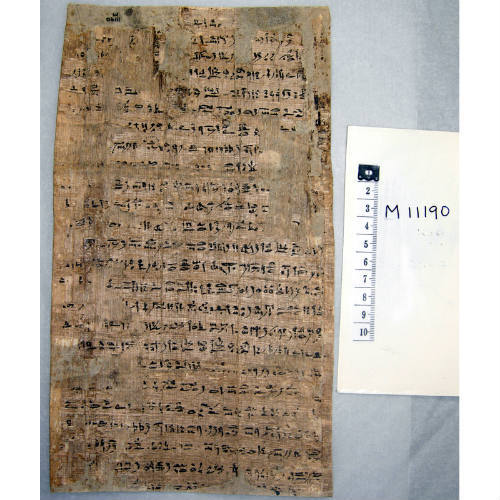
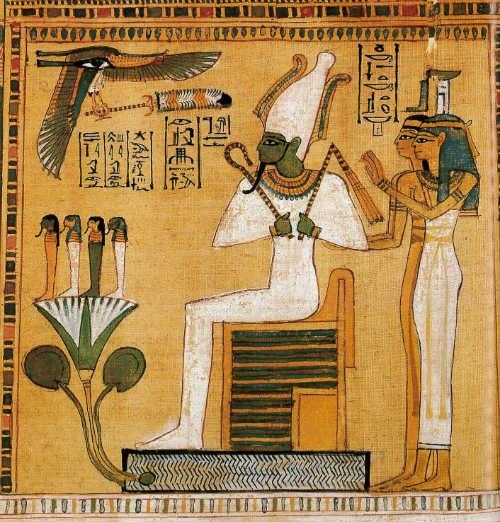
Egyptian papyrus from the Liverpool museum collection (Papyrus Mayer M11190). It shows a religious text from the Ptolemaic Period (332-30 BCE) known as “The Lamentations of Isis and Nephthys”.
youtube
“The Lamentations of Isis and Nephthys” are a series of religious songs addressed to the dead Osiris by his two sisters, Isis and Nephthys. They form part of the ritual of the Osiris mysteries, which was performed in temples on particular occasions to celebrate the life of Osiris and his resurrection after death.
Papyrus M11190 is the last page of the whole manuscript. One of the four remaining pages is held in the Bodleian Libraries at the University of Oxford, and three others are in the British Museum in London.
On the copies of the Lamentations which have survived, a postscript at the end of the songs usually gives instructions about the performance of the ritual. The instructions tell us that two women impersonated Isis and Nephthys during the ceremony:
[they] shall be made to sit on the ground at the main portal of the Hall of Appearings.
On their arms shall be written the names of Isis and Nephthys.
Jars of faience filled with water shall be placed in their right hands, offering loaves made in Memphis in their left hands, and their faces shall be bowed.
(Translation by Miriam Lichtheim in Ancient Egyptian Literature: The Late Period, III, p. 120).
Papyrus M11190 belonged to Pawerem, son of Kiki, a well-known individual of the period who owned several other liturgical papyri. Many private individuals liked to be buried with copies of the Lamentations, as by doing so, they believed they were equipped with the necessary means to be reborn in the Afterlife like Osiris (source).
#leo#lammas#sacrifice#lamentations#ancient egypt#ritual#northern iron age#music#video#Jeffrey Goodman
2 notes
·
View notes
Text
I have had SO many questions since I started watching Agatha all along!
I really wanted to know more about witches, about the lore of this universe, like:
Do witches celebrate sabbats (Yule, Imbolc, Ostara, Beltane, Litha, Lammas, Mabon, Samhain)?
Or is this something we, human, created? And more importantly, does Agatha celebrate sabbats?
Do witches have familiars?
If so, what are they? Are they animals chosen for some reason by the witch? Are they beings of nature (I mean, obviously yes, but magically speaking) that chose the witch, or the witch choose them?
Do witches perform rituals like Drawing down the Moon?
I mean, the only covens we saw performing any ritual were Evanora's, with Agatha's failed attempt at execution, and Agatha's own, when they sang the ballad of the Witches' Road.
Was Evanora the High Priestess of Agatha's old Coven, or its founder?
I disagree with this one myself, because a High Priestess is the role of a woman who's leading a group ritual. High Priestess is also a title sometimes conferred on female members of a Wiccan coven when they have completed their third, or fifth year of study and practice. Evanora looks more like the founder of the Coven.
Are grimoires only made by Coven leaders?
I BLAME THE FANFICS FOR THIS! Every time someone writes about the books Agatha used to learn magic, a lot of people mention that she stole her mother's grimoire after killing her coven, and I always wonder: "Couldn't Agatha create her own grimoire?", "Does every witch have a grimoire?", and things like that.
Why does the Witches' Road classify witches in the Ballad?
Agatha, Jen, Lilia and Alice are witches, they all have knowledge of spells, they know how to use magic, but why the hell did the Witches' Road classify them specifically as "Spirit Witch", "Potion Witch", "Divination Witch" and "Protection Witch"? In terms of witches' powers, do they have any specific magical specialization? That's why?
Why can ONLY those types of witches enter the Road?
Who the fuck decided that only these types of witches can enter the Witches' Road? And why? Can't a witch be a potions witch and a divination witch at the same time? Or it's because of what's in the Witches' Road Ballad?
Like, I have questions, and NOBODY ANSWERS THEM! I honestly feel a little lost, but it's really fun to have these questions, because this series is amazing in everything it proposes.
#agatha all along#agatha harkness#rio vidal#rio agatha all along#jennifer kale#jennifer agatha all along#lilia calderu#lilia agatha all along#alice wu gulliver#alice agatha all along#agathario
25 notes
·
View notes
Text
Important Facts about Lughnasadh from an Irish Celtic Reconstructionist
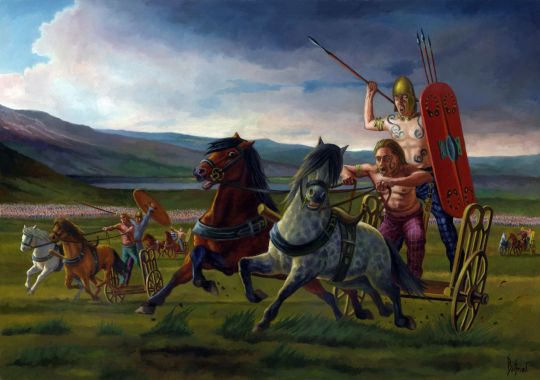
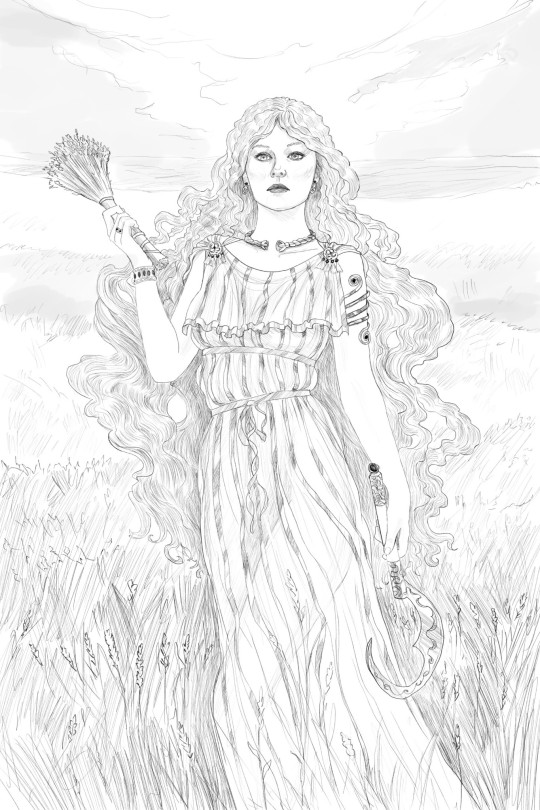
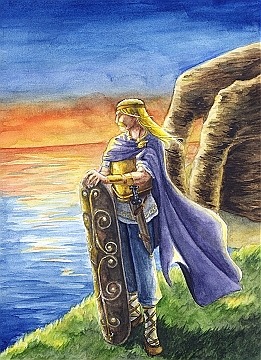
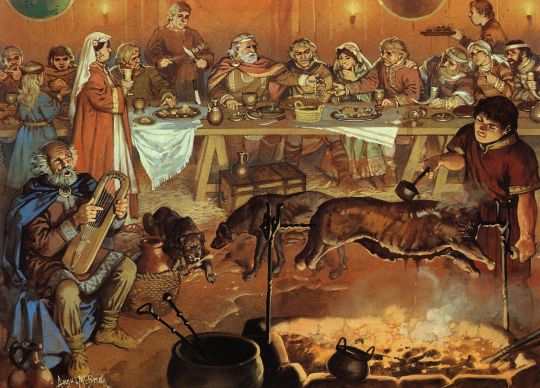
Spelling and Pronunciation
OI. Lughnasadh (Loo-na-sa), sometimes spelled Lughnasa or Modern Irish Lúnasa. Not to be confused with other harvest festivals like Lammas.
Dates
Most reconstructionists celebrate Lughnasadh on July 31st - August 1st from sundown to sundown by the Gregorian calendar, while others choose to celebrate the transitional period between the months as they would have been by the Julian calendar (about 13 days later by the Gregorian calendar).
Traditionally this festival likely would have happened as the grains were ready for harvesting or possibly even when the wild bilberries were ripe (as some scholars mention that if the grains were not ripe they would still preform a ritualized ‘first harvesting’ but it is possible this tradition came after the festival was firmly tied to a calendar date.)
Importance in the Mythos
In the mythologies it is well documented that this festival coincides with Lugh’s funeral games in honor of his foster-mother Tailtiu, known as Aonach Tailteann. In the mythologies she is said to have died of exhaustion after clearing the plains of Ireland for agricultural needs. The first documented instance of Lughnasadh in the mythologies was in the Wooing of Emer, Tochmarc Emire, which makes sense given the importance of marriages at this time of the year. It is not known specifically but widely speculated that the curse of the Ulstermen by Macha took place at a horse race for this festival.
In later time periods it is common to see a form of struggle, normally between the ‘protective’ forces and ‘destructive’ forces. The modern equivalent being the struggle between Saint Patrick and Crom Dubh but this is likely a reflection of an early struggle between Lugh and Balor (which I previously mentioned in my info-dump on Bealtaine).
Celebration Traditions
Aonachs, funeral games, have (to the best of our knowledge) been a custom in Ireland since the bronze age and were practiced on and off into the middle ages. They had both personal and community functions and occurred in three stages. Stage one was the funeral proceedings themselves. They would last one to three days, likely depending on the importance of the individual in question. Mourning songs and chants were participated in by both the attendees and the Druids. The second stage was for proclaiming of laws. Aonachs were a time when universal peace between túaths was declared. The third stage was that of Cuiteach Fuait, games that tested mental and physical abilities. These games included the well known horse and chariot races, wrestling games, boxing, high jumps but also competitions in strategy, singing, story telling and between various skilled craftsmen.
It was incredibly common for marriages to be arranged and preformed during this festival. More well known ‘trial marriages’ (lasting a year and a day) were still preformed at this festival up until the 13th century. It is likely that the coupling occurring at this time of year had an effect on the relationship to births seen at Imbolg (which falls 9 months later).
MacNeill, a leading scholarly expert on the festival, notes that a ritualistic bull sacrifice was made at this festival and the bull would then be eaten. I could not find any definitive evidence to support the idea, but I think it was likely that bulls in general would be culled from the herd at this point in the year to supply the feast.
Art credit @ire-ethereal
My Kofi
#irish#irish mythology#celtic#irish paganism#irish polytheism#paganism#celtic paganism#celtic polytheism#pagan#celtic reconstructionist#celtic reconstructionism#celtic mythology#irish reconstructionism#irish reconstructionist#festival#fire festival#lugh#lughnasadh#Lughnasa#NOT lammas#Tailtiu#harvest#blackcrowing
347 notes
·
View notes
Text
August 2023 witch guide
August 2023 witch guide
Full moon: August 1st in Aquarius
New Moon: August 16th
Blue moon: August 30th Aquarius into Pisces
Sabbats: Lughnasadh August 1st
August Sturgeon Moon
Also known as: Corn moon, harvest moon, ricing moon, barley moon, dog moon, fruit moon, grain moon, herb moon, red moon & wyrt moon
Element: Fire
Zodiac: Leo & Virgo
Animal spirts: Dryads
Deities: Diana, Ganesha, Hathor, Hecate, Mars, Nemesis, Thot & Vulcan
Animals: Dragon, lion, phoenix & sphinx
Birds: Crane, eagle & falcon
Trees: Alder cedar & hazel
Herbs/plants: Basil, bay, chamomile, fennel, orange, rosemary, rue & St. John's wort,
Flowers: Angelica, marigold, sunflower
Scents: Frankincense & heliotrope
Stones: Carnelian, cats/tiger's eye, fire agate, garnet, red jasper & red agate
Colors: Gold, orange, red & yellow
Energy: Authority, appreciation, courage, entertainment, finding your voice, friendship, gathering, harvesting energy, health, love, pleasures, power &vitality
Sturgeon moon gets it's name from the high numbers that are caught at the Great Lakes & Lake Champlain in North America during this time of year. The names come from a number of places including Native Americans, Colonial Americans & European sources.
Lughnasadh
Also known as: Lammas, August eve & Feast of bread
Season: Summer
Symbols: Scythes, corn, grain dollies & shafts of grain
Colors: Gold, green, yellow, red, orange, light brown & purple
Oils/incense: Aloe, apple, corn, eucalyptus, safflower, rose & sandalwood
Animals: Cattle & chickens
Stones: Aventurine, carnelian, citrine, peridot, sardonyx & yellow diamond
Foods: Apples, grains, barley cakes, wild berries, cider, honey, potatoes, rice, sun shaped cookies, blackberry, corn, nuts, breads, blueberry. berry pies & grapes
Herbs/Plants: Alfalfa, aloe, all grains, blackberry, corn, corn stalk, crab apple, fenugreek, frankincense, ginseng, goldenseal, grapes, myrtle, oak leaves, pear, rye, blackthorn &wheat
Flowers: Sunflower, cyclamen, heather, hollyhock & medowsweet
Goddesses: Aine, Alphito, Bracacia, Carmen, Ceres, Damina, Demeter, Freya, Grain goddesses, Ishtar, Kait, Kore, Mother Goddess, Sul, Sun Goddesses, Taillte, Zaramama, Ereshkigal & Ianna
Gods: Athar, Bes, Bran, Dagon, Ebisu, Dumuzi, Ghanan, Grain Gods, Howtu, Liber, Lono, Lugh, Neper, Odin, Sun Gods & Xochipilli
Issues, Intentions & Power: Agriculture, changes, divination, endings, fertility, life, light, manifestation, power, purpose, strength, success & unity
Spellwork: Sun magick, rituals of thanks/offerings, bounty, abundance & fire magick
Activities:
Bake fresh bread
Weave wheat
Take walks along bodies of water
Craft a corn doll
Watch the sunrise
Eat outside with family/friends/coven members
Donate to your local foodbank
Prepare a feast with your garden harvest
Give thanks to the Earth
Decorate your altar with symbols of the season
Clean up a space in nature
Plant saved seeds
This cross-quarter fire festival is celebrated on August 1st or the first full moon of Leo & the seventh sabbat of the year. It represents the first harvest when the Earth's bounty is given for the abundance received.
Some believe this is the time where the God has weakened & is losing his strength as seen in the waning of the day's light. The Goddess is pregnant with the young God who will be born on Yule.
In some traditions, this day honors the Celt god Lugh, the god of craftsmanship; He is skilled in many things including wheel making, blacksmithing & fighting. Though there is some discrepancy as to why Lugh is honored on this day. Some tales say it's because he held a harvest faire in honor of his adoptive mother, Tailtiu.
Sources;
Farmersalmanac .com
Boston Public Library- The Origins & Practices of Lammas/Lughnasadh by Dhruti Bhagat
Llewellyn's Complete Book of Correspondences by Sandra Kines
A Witch's Book of Correspondences by Viktorija Briggs
#witchcraft#wheel of the year#sabbat#lughnasadh#lammas#sturgeon moon#witchblr#wiccablr#paganblr#pagan#wicca#grimoire#book of shadows#witches of tumblr#tumblr witch#moon magic#witch tips#Witch guide#witchy things#traditional witchcraft#witch community#witch society#greenwitchcrafts#spellwork#witches#witch friends#all witches#correspondence
501 notes
·
View notes